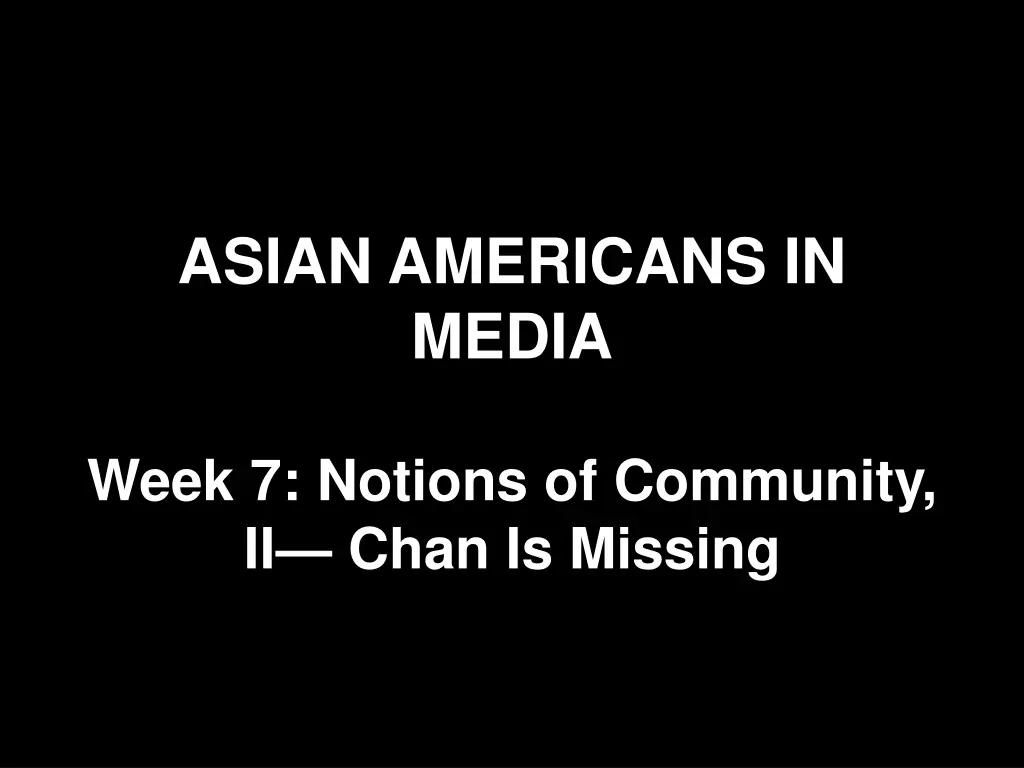
Exploring Wayne Wang's Contributions to Asian American Cinema
Discover the impact of Wayne Wang, a prominent Asian American filmmaker, on the world of cinema. From his groundbreaking film "Chan Is Missing" to his diverse filmography, Wang has paved the way for Asian American representation in media. Learn about his unique storytelling approach and the cultural significance of his work in this insightful examination of his career.
Download Presentation

Please find below an Image/Link to download the presentation.
The content on the website is provided AS IS for your information and personal use only. It may not be sold, licensed, or shared on other websites without obtaining consent from the author. If you encounter any issues during the download, it is possible that the publisher has removed the file from their server.
You are allowed to download the files provided on this website for personal or commercial use, subject to the condition that they are used lawfully. All files are the property of their respective owners.
The content on the website is provided AS IS for your information and personal use only. It may not be sold, licensed, or shared on other websites without obtaining consent from the author.
E N D
Presentation Transcript
ASIAN AMERICANS IN MEDIA Week 7: Notions of Community, II Chan Is Missing
Key Terms: Asian American feature films Asian American identity Hyphenated identity / the interval Assimilation / hybridity Asian American subjectivity / Asian American identity Postmodernism and film
Chan Is Missing (1982) Dir. Wayne Wang Starring Wood Moy, Marc Hayashi, Laureen Chew, Peter Wang
Wayne Wang Born in Hong Kong, 1949, and named after his father s favorite movie star - guess who? Educated in H.K. and the U.S.; studied film and television at California College of Arts and Crafts
After graduating from CCA, Wang worked in activist and theater groups in San Francisco s Chinatown. Chan Is Missing is Wang s second film; his first was A Man, a Woman and a Killer (1975), which he made while still in art school. He subsequently made Dim Sum: A Little Bit of Heart (1985), Eat A Bowl of Tea (1989), Joy Luck Club (1993).
Not all of Wang s films are Asian American in theme, e.g. Maid in Manhattan (2002) Wang is one of the few Asian American filmmakers from his generation who successfully made a transition from the artist / activist / scholar mode to a more commercial career
He is still making films in the indiewood mode, recent titles include Smoke and Blue in The Face (both 1995), Center of The World (2001), A Thousand Years of Good Prayers and The Princess of Nebraska (both 2007), Snow Flower and the Secret Fan (2011) Interviews in Moving The Image and Out of The Shadows
Chan Is Missing is one of the first Asian American independent feature films produced outside the studio system. It was shot in B&W 16mm film, produced for less than $25,000. The film was shot on location in San Francisco s Chinatown, featuring its inhabitants, who often play themselves in largely improvised scenes
Filmed in English, Chinese (Cantonese and Mandarin), Spanish; early version were not subtitled. Also featured a soundtrack with music from different communities. Based on a true story: the film was dedicated to Wong Cheen, the husband of one of Wang s friends from Taiwan who went missing for several weeks.
Discussion Questions: Which communities are represented in the film? Describe them.
Discussion Questions: Which communities are represented in the film? Describe them. Who is the audience for this film?
Discussion Questions: Which communities are represented in the film? Describe them. Who is the audience for this film? Who is Chan?
Discussion Questions: Is CIM similar to other feature narratives (BROKEN BLOSSOMS, DAUGHTER OF THE DRAGON, THE GOOD EARTH, FLOWER DRUM SONG) you ve seen in this class so far?
Discussion Questions: Is CIM similar to other feature narratives (BROKEN BLOSSOMS, DAUGHTER OF THE DRAGON, THE GOOD EARTH, FLOWER DRUM SONG) you ve seen in this class so far? If not, what other narrative films does it remind you of?
Discussion Questions: What is the space of the interval and the hyphen that Feng discusses in his essay, and how do these ideas relate to this film?
Discussion Questions: What is the space of the interval and the hyphen that Feng discusses in his essay, and how do these ideas relate to this film? What do you think the protagonist (and by extension, Wang) meant when he said, using the negative to emphasize the positive ?
